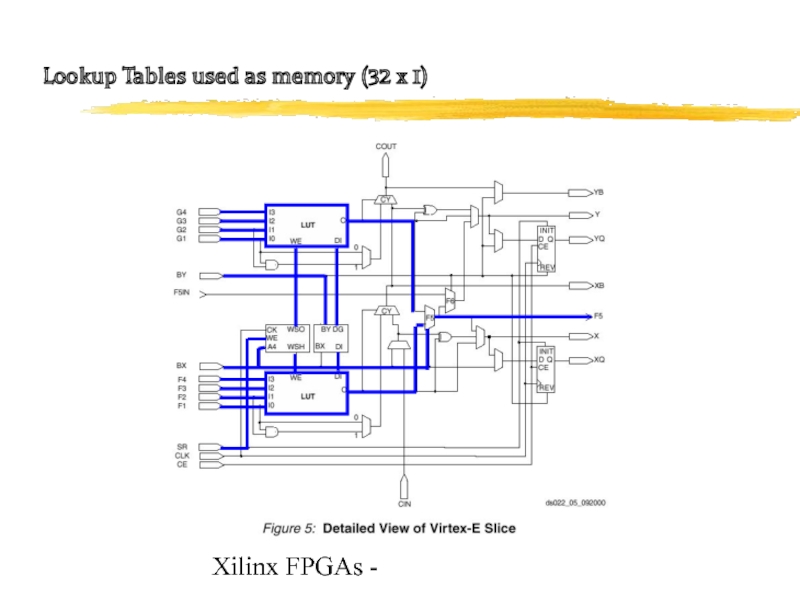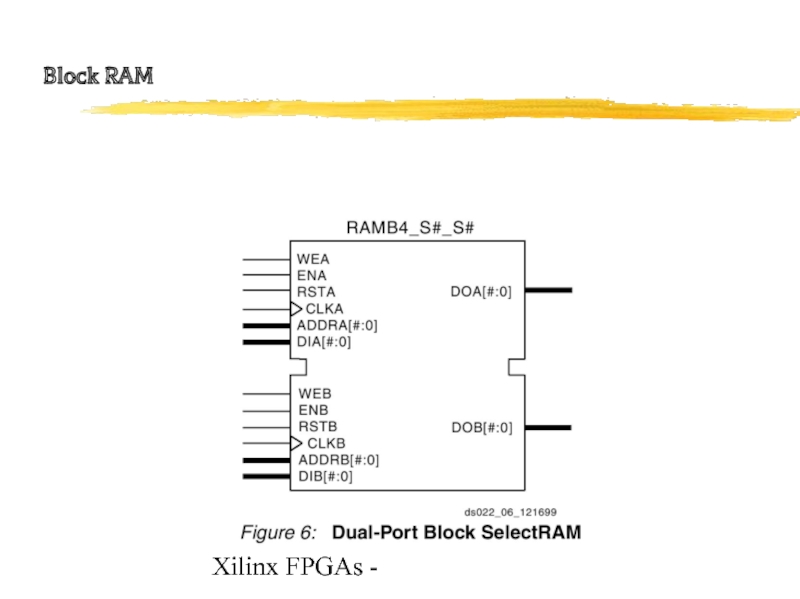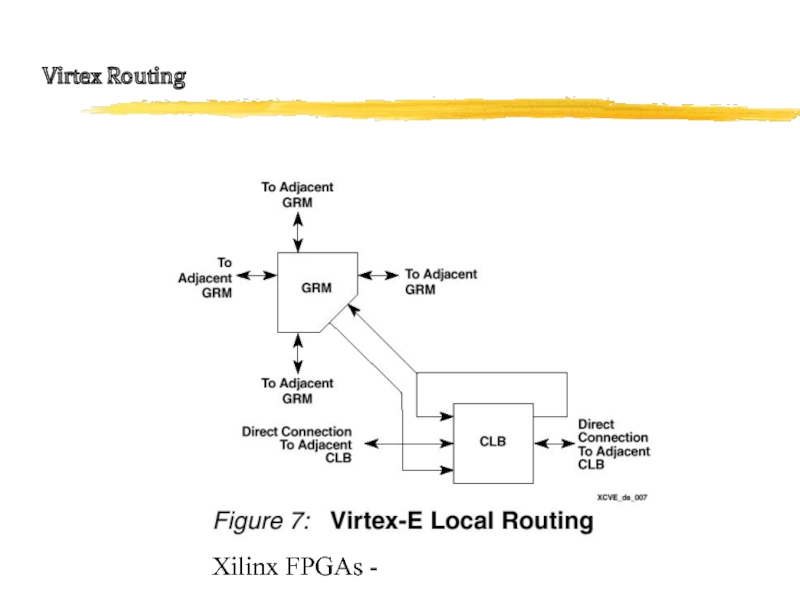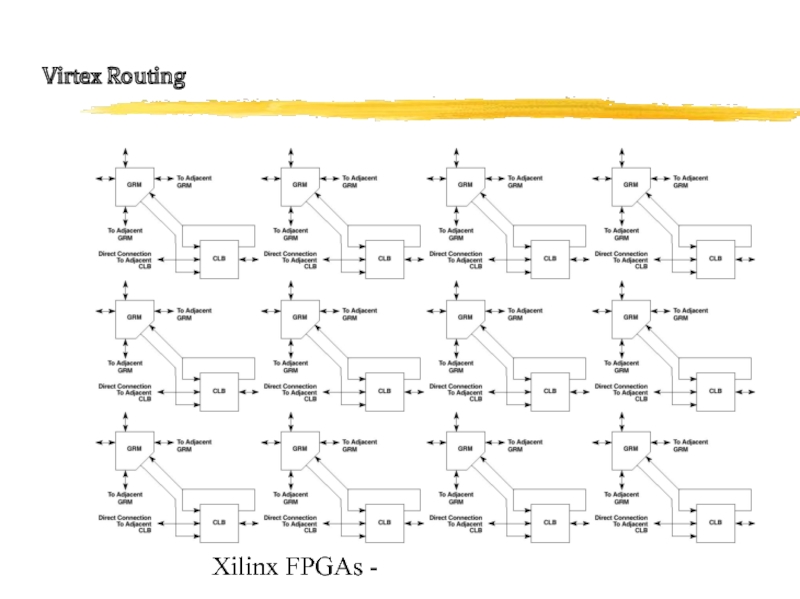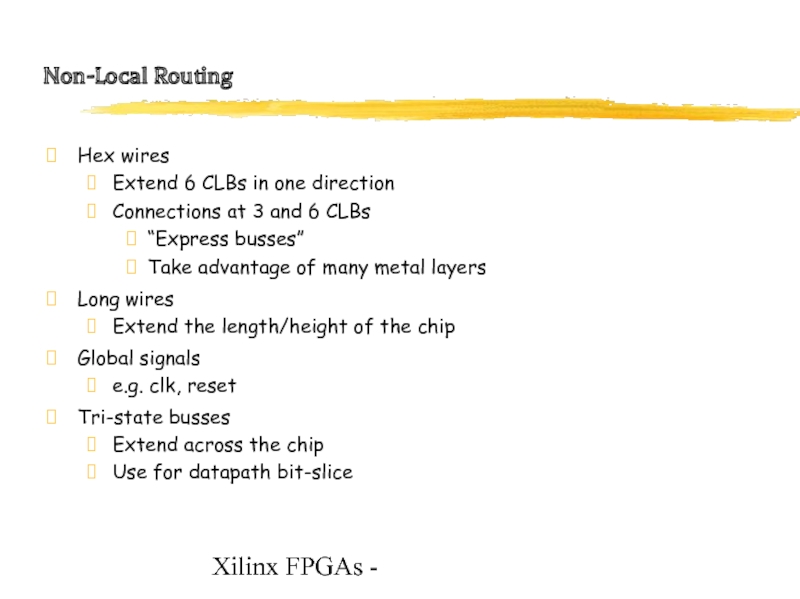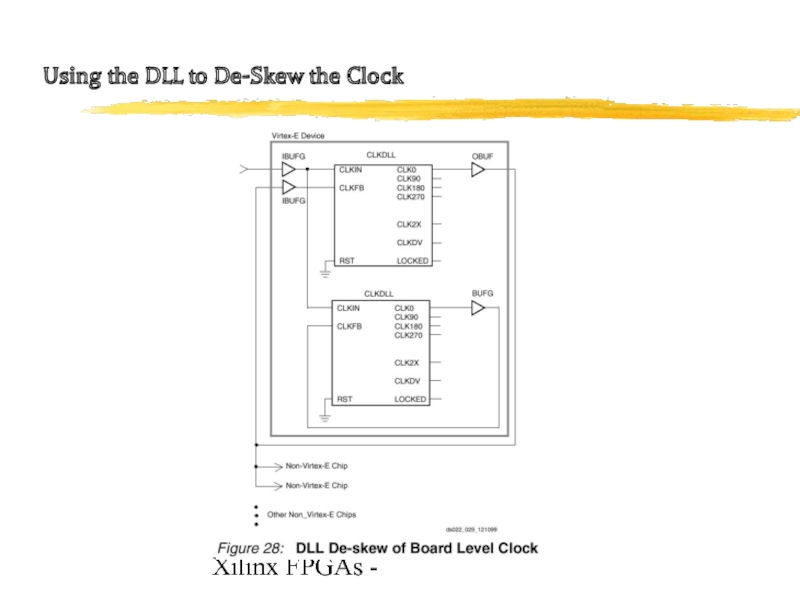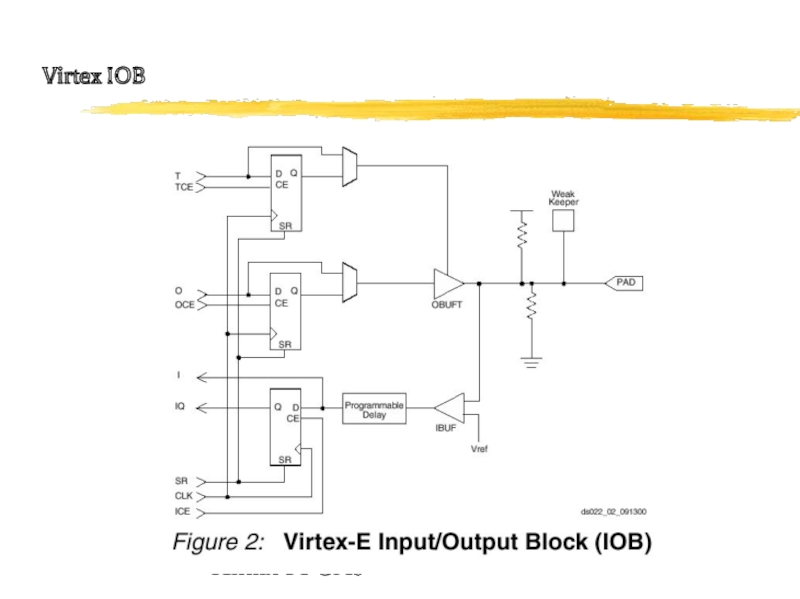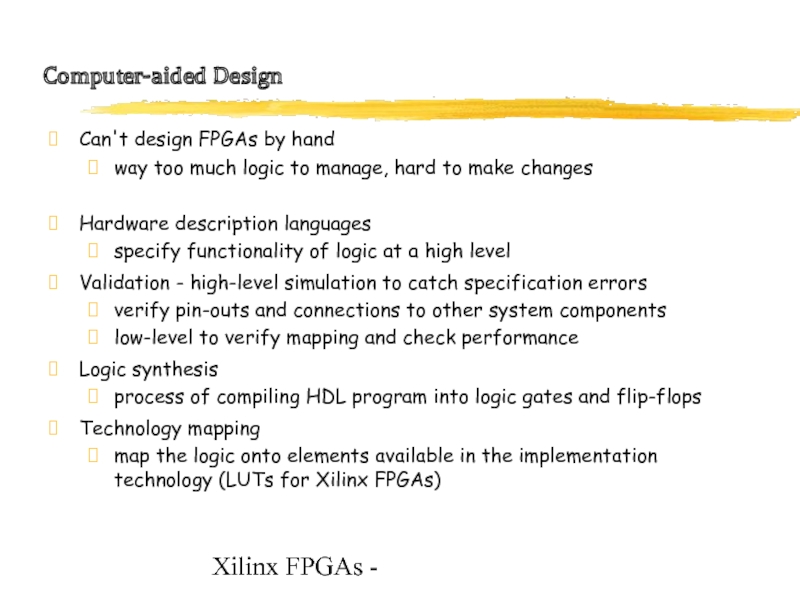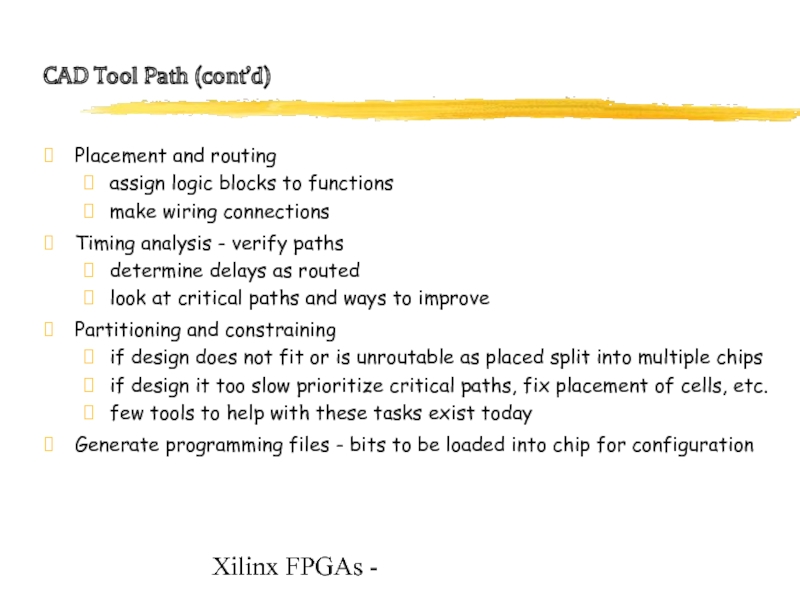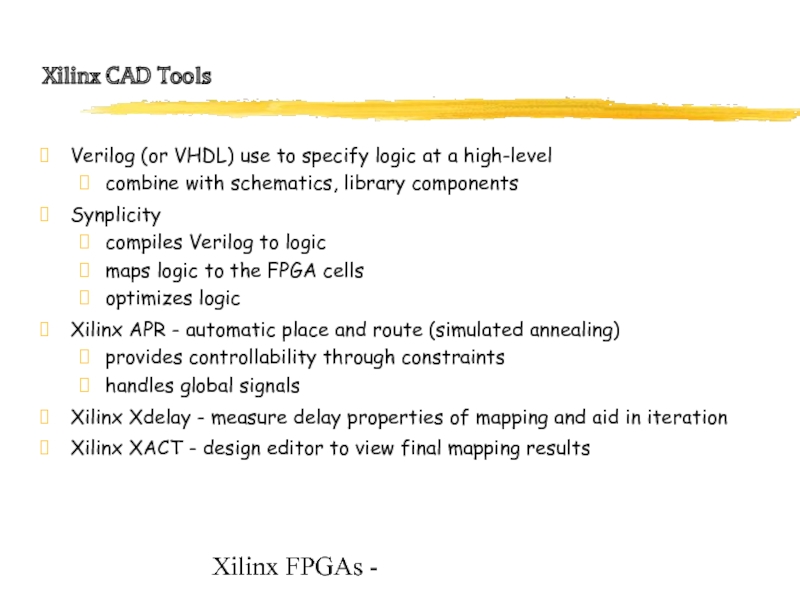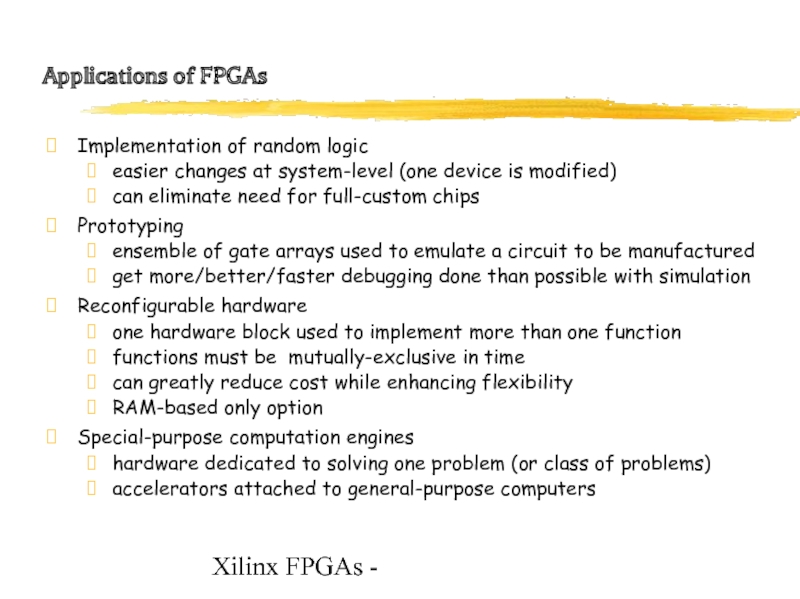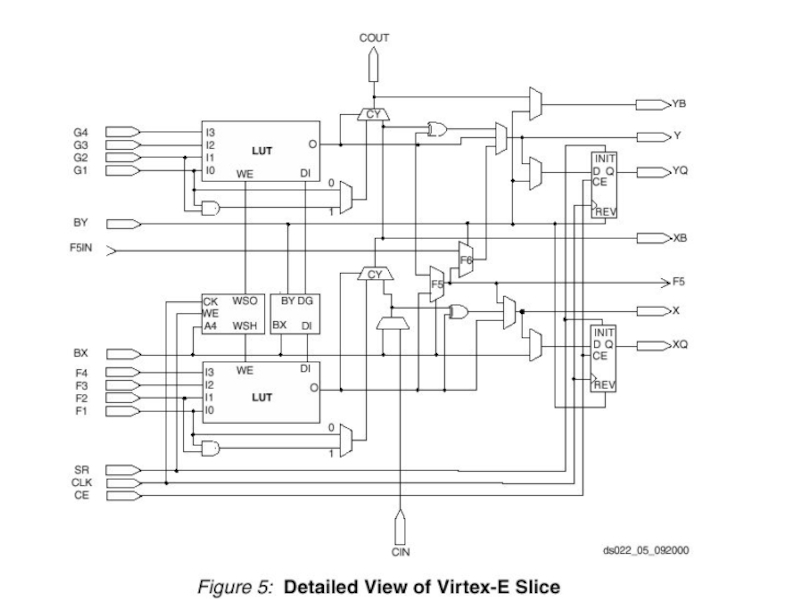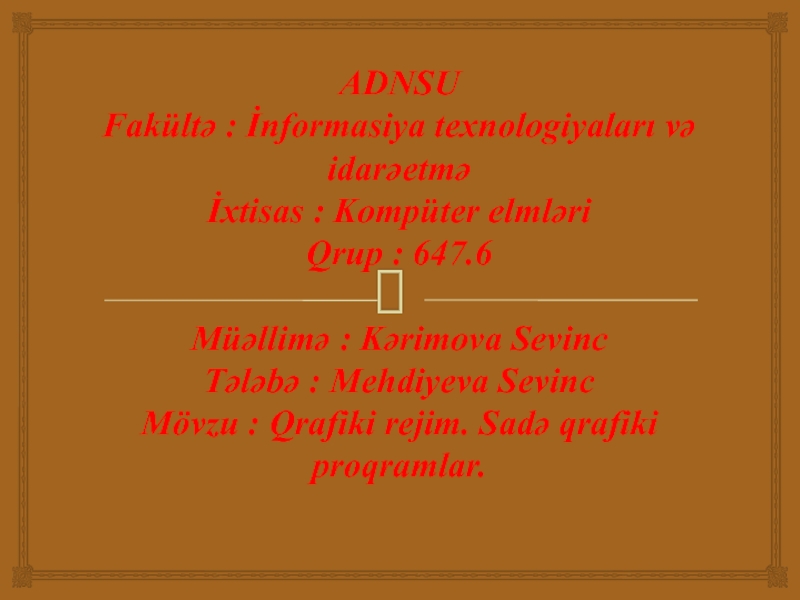Logic gates (1950s-60s)
Regular structures for two-level logic (1960s-70s)
muxes and decoders, PLAs
Programmable sum-of-products arrays (1970s-80s)
PLDs, complex PLDs
Programmable gate arrays (1980s-90s)
densities high enough to permit entirely new
class of application, e.g., prototyping, emulation,
acceleration
- Главная
- Разное
- Дизайн
- Бизнес и предпринимательство
- Аналитика
- Образование
- Развлечения
- Красота и здоровье
- Финансы
- Государство
- Путешествия
- Спорт
- Недвижимость
- Армия
- Графика
- Культурология
- Еда и кулинария
- Лингвистика
- Английский язык
- Астрономия
- Алгебра
- Биология
- География
- Детские презентации
- Информатика
- История
- Литература
- Маркетинг
- Математика
- Медицина
- Менеджмент
- Музыка
- МХК
- Немецкий язык
- ОБЖ
- Обществознание
- Окружающий мир
- Педагогика
- Русский язык
- Технология
- Физика
- Философия
- Химия
- Шаблоны, картинки для презентаций
- Экология
- Экономика
- Юриспруденция
Evolution of implementation technologies презентация
Содержание
- 1. Evolution of implementation technologies
- 2. Xilinx FPGAs - Gate Array
- 3. Xilinx FPGAs - Field-Programmable Gate
- 4. Xilinx FPGAs - Enabling Technology Cheap/fast
- 5. Xilinx FPGAs - Programming Technologies
- 6. Xilinx FPGAs - Tradeoffs in FPGAs
- 7. Xilinx FPGAs - Xilinx Programmable Gate
- 8. Xilinx FPGAs -
- 9. Xilinx FPGAs - The Virtex CLB
- 10. Xilinx FPGAs - Details of One Virtex Slice
- 11. Xilinx FPGAs - Implements any Two 4-input Functions 4-input function 3-input function; registered
- 12. Xilinx FPGAs - Implements any 5-input Function 5-input function
- 13. Xilinx FPGAs - Implement Some Larger Functions e.g. 9-input parity
- 14. Xilinx FPGAs - Two Slices: Any 6-input Function 6-input function from other slice
- 15. Xilinx FPGAs - Two Slices: Implement
- 16. Xilinx FPGAs - Fast Carry Chain:
- 17. Xilinx FPGAs - Lookup Tables used
- 18. Xilinx FPGAs - Lookup Tables used as memory (32 x 1)
- 19. Xilinx FPGAs - Block RAM
- 20. Xilinx FPGAs - Virtex Routing
- 21. Xilinx FPGAs - Virtex Routing
- 22. Xilinx FPGAs - Non-Local Routing Hex
- 23. Xilinx FPGAs - Using the DLL to De-Skew the Clock
- 24. Xilinx FPGAs - Virtex IOB
- 25. Xilinx FPGAs - Computer-aided Design Can't
- 26. Xilinx FPGAs - CAD Tool Path
- 27. Xilinx FPGAs - Xilinx CAD Tools
- 28. Xilinx FPGAs - Applications of FPGAs
- 29. Xilinx FPGAs -
Слайд 1Xilinx FPGAs -
trend toward
higher levels
of integration
Evolution of implementation
technologies
Слайд 2Xilinx FPGAs -
Gate Array Technology (IBM - 1970s)
Simple logic gates
combine
transistors to
implement combinational
and sequential logic
Interconnect
wires to connect inputs and outputs to logic blocks
I/O blocks
special blocks at periphery for external connections
Add wires to make connections
done when chip is fabbed
“mask-programmable”
construct any circuit
Interconnect
wires to connect inputs and outputs to logic blocks
I/O blocks
special blocks at periphery for external connections
Add wires to make connections
done when chip is fabbed
“mask-programmable”
construct any circuit
Слайд 3Xilinx FPGAs -
Field-Programmable Gate Arrays
Logic blocks
to implement combinational
and sequential logic
Interconnect
wires
to connect inputs and
outputs to logic blocks
I/O blocks
special logic blocks at periphery of device for external connections
Key questions:
how to make logic blocks programmable?
how to connect the wires?
after the chip has been fabbed
I/O blocks
special logic blocks at periphery of device for external connections
Key questions:
how to make logic blocks programmable?
how to connect the wires?
after the chip has been fabbed
Слайд 4Xilinx FPGAs -
Enabling Technology
Cheap/fast fuse connections
small area (can fit lots
of them)
low resistance wires (fast even if in multiple segments)
very high resistance when not connected
small capacitance (wires can be longer)
Pass transistors (switches)
used to connect wires
bi-directional
Multiplexors
used to connect one of a set of possible sources to input
can be used to implement logic functions
low resistance wires (fast even if in multiple segments)
very high resistance when not connected
small capacitance (wires can be longer)
Pass transistors (switches)
used to connect wires
bi-directional
Multiplexors
used to connect one of a set of possible sources to input
can be used to implement logic functions
Слайд 5Xilinx FPGAs -
Programming Technologies
Fuse and anti-fuse
fuse makes or breaks link
between two wires
typical connections are 50-300 ohm
one-time programmable
Flash
High density
Process issues
RAM-based
memory bit controls a switch that connects/disconnects two wires
typical connections are .5K-1K ohm
can be programmed and re-programmed easily (tested at factory)
typical connections are 50-300 ohm
one-time programmable
Flash
High density
Process issues
RAM-based
memory bit controls a switch that connects/disconnects two wires
typical connections are .5K-1K ohm
can be programmed and re-programmed easily (tested at factory)
Слайд 6Xilinx FPGAs -
Tradeoffs in FPGAs
Logic block - how are functions
implemented: fixed functions (manipulate inputs) or programmable?
support complex functions, need fewer blocks, but they are bigger so less of them on chip
support simple functions, need more blocks, but they are smaller so more of them on chip
Interconnect
how are logic blocks arranged?
how many wires will be needed between them?
are wires evenly distributed across chip?
programmability slows wires down – are some wires specialized to long distances?
how many inputs/outputs must be routed to/from each logic block?
what utilization are we willing to accept? 50%? 20%? 90%?
support complex functions, need fewer blocks, but they are bigger so less of them on chip
support simple functions, need more blocks, but they are smaller so more of them on chip
Interconnect
how are logic blocks arranged?
how many wires will be needed between them?
are wires evenly distributed across chip?
programmability slows wires down – are some wires specialized to long distances?
how many inputs/outputs must be routed to/from each logic block?
what utilization are we willing to accept? 50%? 20%? 90%?
Слайд 7Xilinx FPGAs -
Xilinx Programmable Gate Arrays
CLB - Configurable Logic Block
5-input,
1 output function
or 2 4-input, 1 output functions
optional register on outputs
Built-in fast carry logic
Can be used as memory
Three types of routing
direct
general-purpose
long lines of various lengths
RAM-programmable
can be reconfigured
or 2 4-input, 1 output functions
optional register on outputs
Built-in fast carry logic
Can be used as memory
Three types of routing
direct
general-purpose
long lines of various lengths
RAM-programmable
can be reconfigured
Слайд 11Xilinx FPGAs -
Implements any Two 4-input Functions
4-input function
3-input function;
registered
Слайд 15Xilinx FPGAs -
Two Slices: Implement some larger functions
e.g. 19-input parity
from
other slice
Слайд 22Xilinx FPGAs -
Non-Local Routing
Hex wires
Extend 6 CLBs in one direction
Connections
at 3 and 6 CLBs
“Express busses”
Take advantage of many metal layers
Long wires
Extend the length/height of the chip
Global signals
e.g. clk, reset
Tri-state busses
Extend across the chip
Use for datapath bit-slice
“Express busses”
Take advantage of many metal layers
Long wires
Extend the length/height of the chip
Global signals
e.g. clk, reset
Tri-state busses
Extend across the chip
Use for datapath bit-slice
Слайд 25Xilinx FPGAs -
Computer-aided Design
Can't design FPGAs by hand
way too much
logic to manage, hard to make changes
Hardware description languages
specify functionality of logic at a high level
Validation - high-level simulation to catch specification errors
verify pin-outs and connections to other system components
low-level to verify mapping and check performance
Logic synthesis
process of compiling HDL program into logic gates and flip-flops
Technology mapping
map the logic onto elements available in the implementation technology (LUTs for Xilinx FPGAs)
Hardware description languages
specify functionality of logic at a high level
Validation - high-level simulation to catch specification errors
verify pin-outs and connections to other system components
low-level to verify mapping and check performance
Logic synthesis
process of compiling HDL program into logic gates and flip-flops
Technology mapping
map the logic onto elements available in the implementation technology (LUTs for Xilinx FPGAs)
Слайд 26Xilinx FPGAs -
CAD Tool Path (cont’d)
Placement and routing
assign logic blocks
to functions
make wiring connections
Timing analysis - verify paths
determine delays as routed
look at critical paths and ways to improve
Partitioning and constraining
if design does not fit or is unroutable as placed split into multiple chips
if design it too slow prioritize critical paths, fix placement of cells, etc.
few tools to help with these tasks exist today
Generate programming files - bits to be loaded into chip for configuration
make wiring connections
Timing analysis - verify paths
determine delays as routed
look at critical paths and ways to improve
Partitioning and constraining
if design does not fit or is unroutable as placed split into multiple chips
if design it too slow prioritize critical paths, fix placement of cells, etc.
few tools to help with these tasks exist today
Generate programming files - bits to be loaded into chip for configuration
Слайд 27Xilinx FPGAs -
Xilinx CAD Tools
Verilog (or VHDL) use to specify
logic at a high-level
combine with schematics, library components
Synplicity
compiles Verilog to logic
maps logic to the FPGA cells
optimizes logic
Xilinx APR - automatic place and route (simulated annealing)
provides controllability through constraints
handles global signals
Xilinx Xdelay - measure delay properties of mapping and aid in iteration
Xilinx XACT - design editor to view final mapping results
combine with schematics, library components
Synplicity
compiles Verilog to logic
maps logic to the FPGA cells
optimizes logic
Xilinx APR - automatic place and route (simulated annealing)
provides controllability through constraints
handles global signals
Xilinx Xdelay - measure delay properties of mapping and aid in iteration
Xilinx XACT - design editor to view final mapping results
Слайд 28Xilinx FPGAs -
Applications of FPGAs
Implementation of random logic
easier changes at
system-level (one device is modified)
can eliminate need for full-custom chips
Prototyping
ensemble of gate arrays used to emulate a circuit to be manufactured
get more/better/faster debugging done than possible with simulation
Reconfigurable hardware
one hardware block used to implement more than one function
functions must be mutually-exclusive in time
can greatly reduce cost while enhancing flexibility
RAM-based only option
Special-purpose computation engines
hardware dedicated to solving one problem (or class of problems)
accelerators attached to general-purpose computers
can eliminate need for full-custom chips
Prototyping
ensemble of gate arrays used to emulate a circuit to be manufactured
get more/better/faster debugging done than possible with simulation
Reconfigurable hardware
one hardware block used to implement more than one function
functions must be mutually-exclusive in time
can greatly reduce cost while enhancing flexibility
RAM-based only option
Special-purpose computation engines
hardware dedicated to solving one problem (or class of problems)
accelerators attached to general-purpose computers
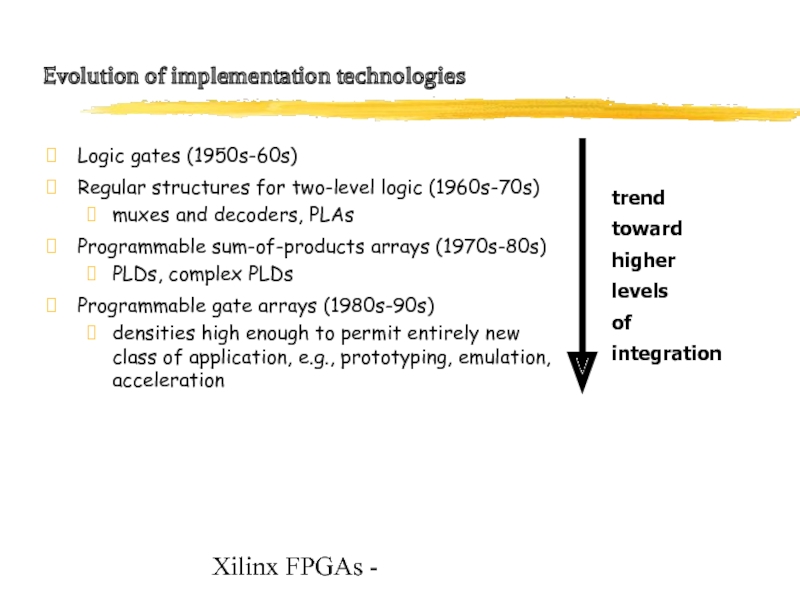
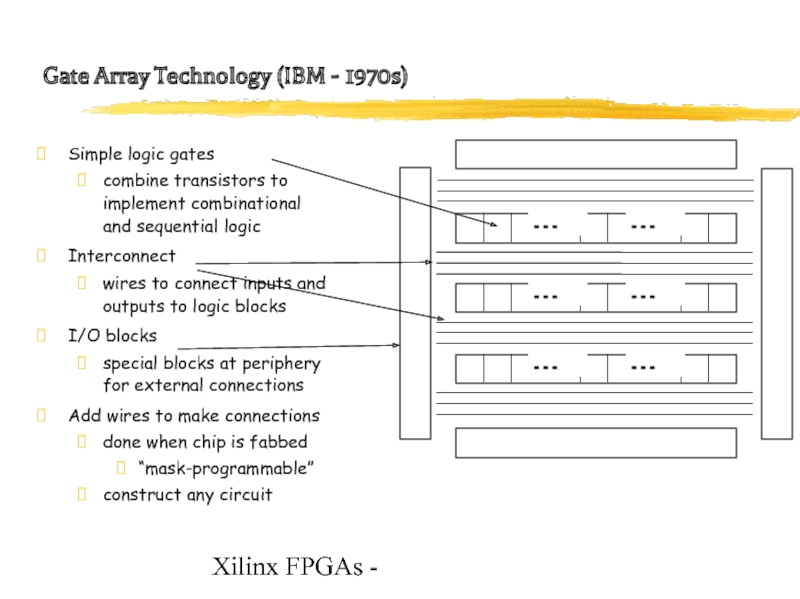
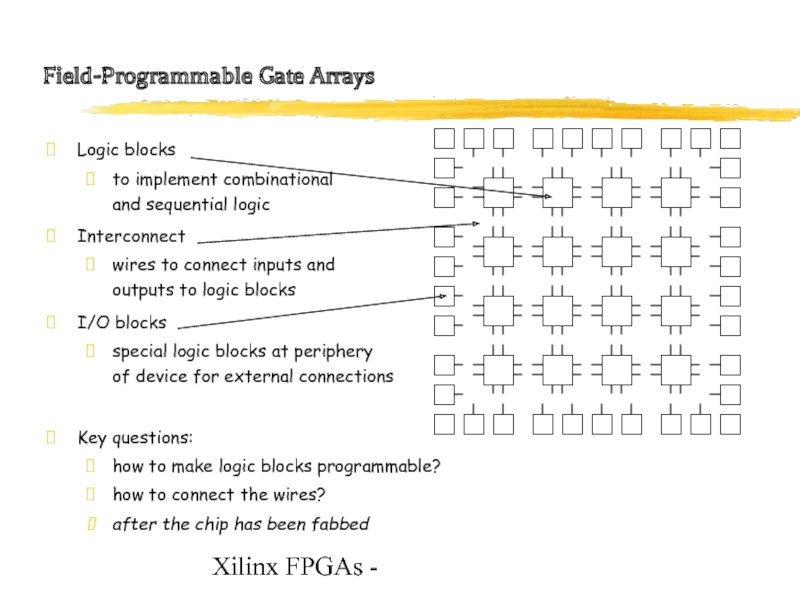
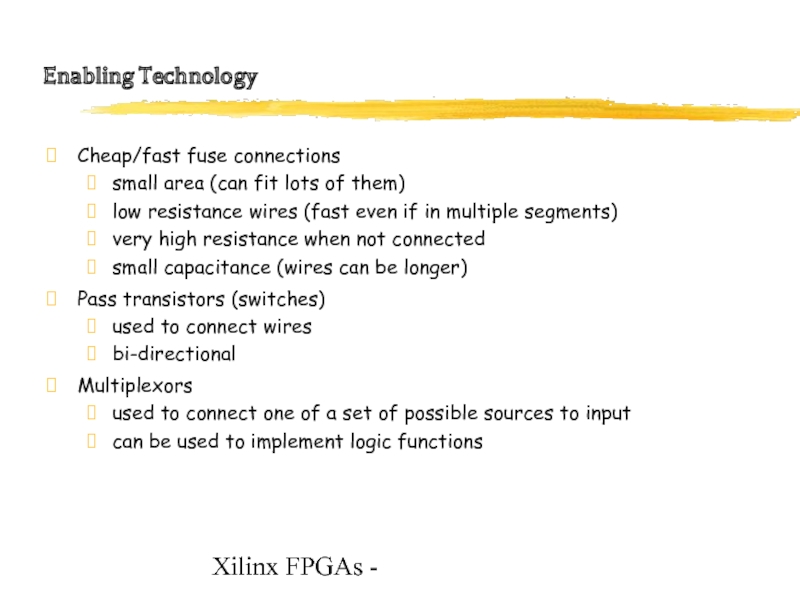
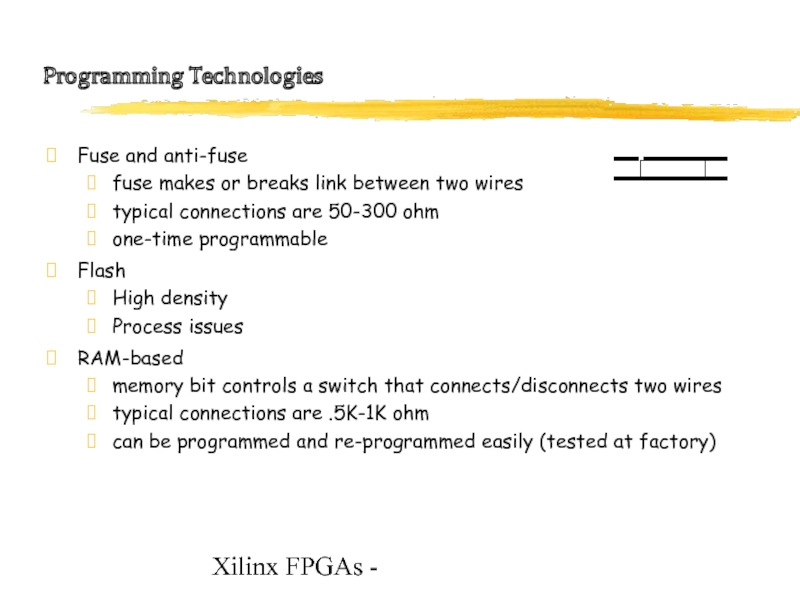
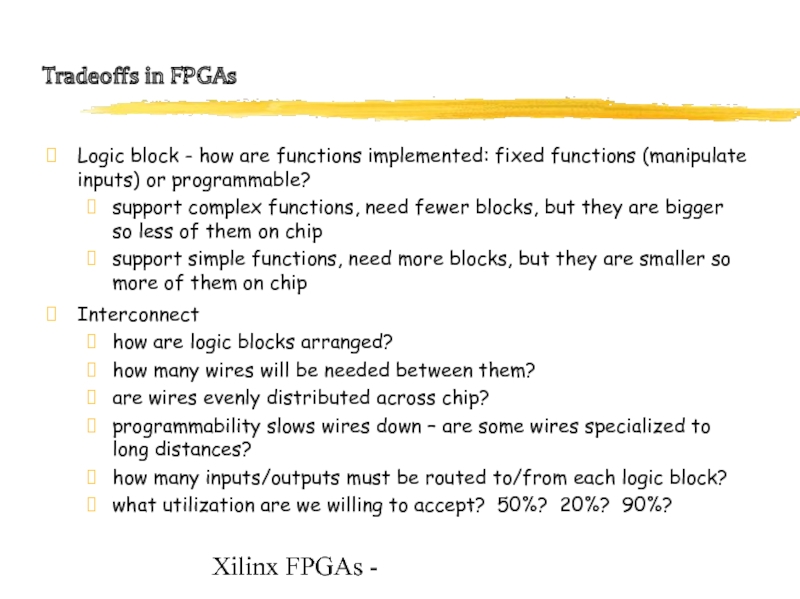
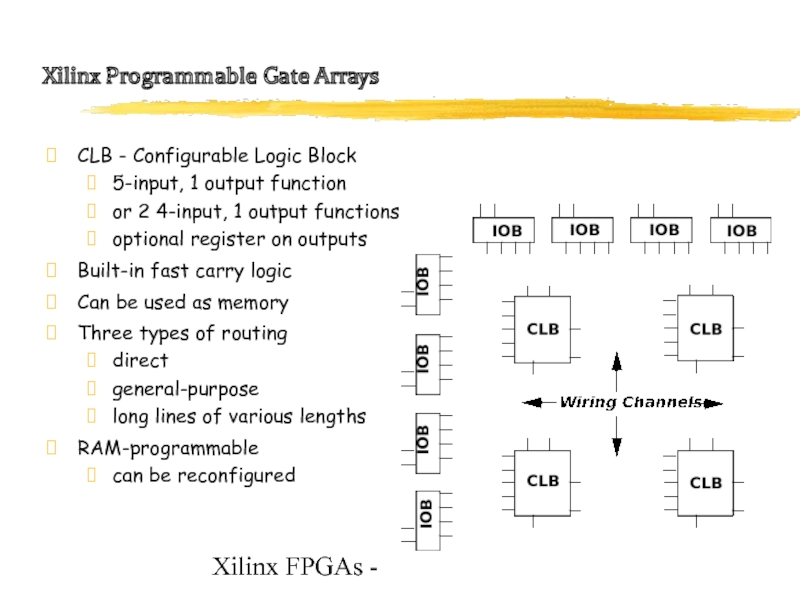
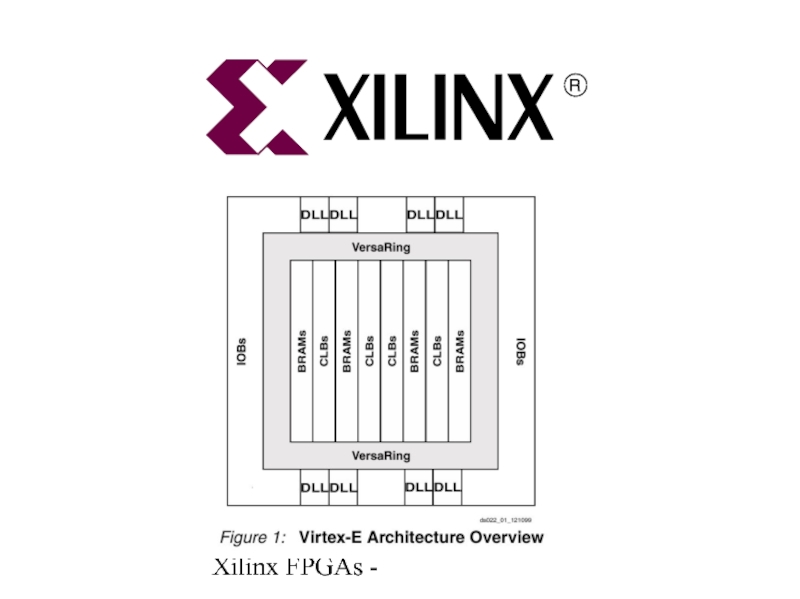
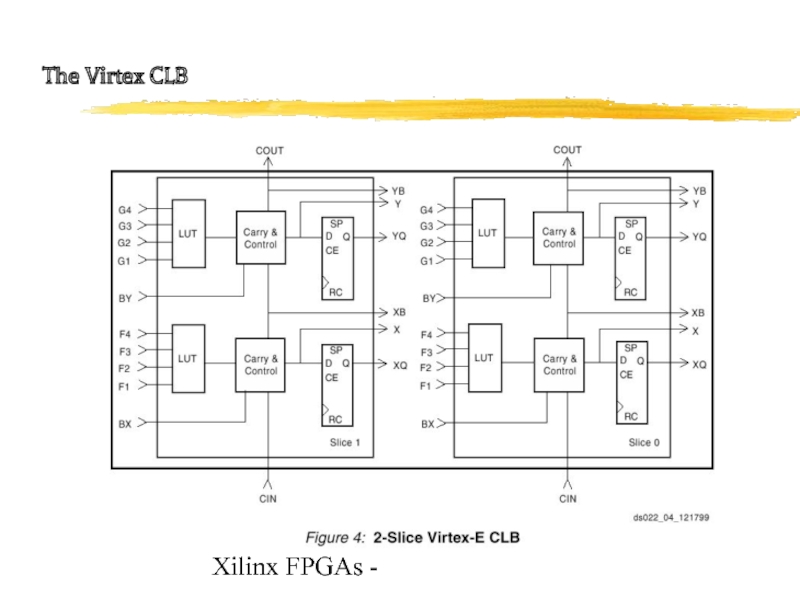
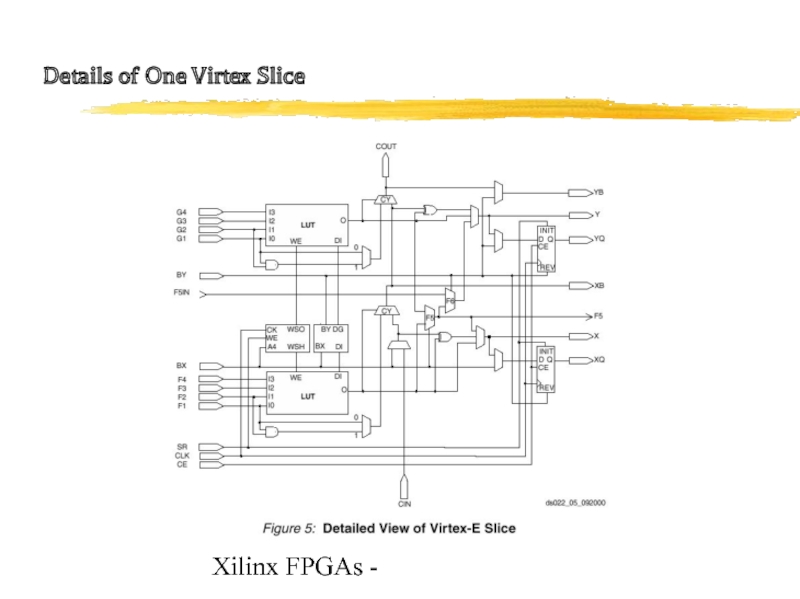
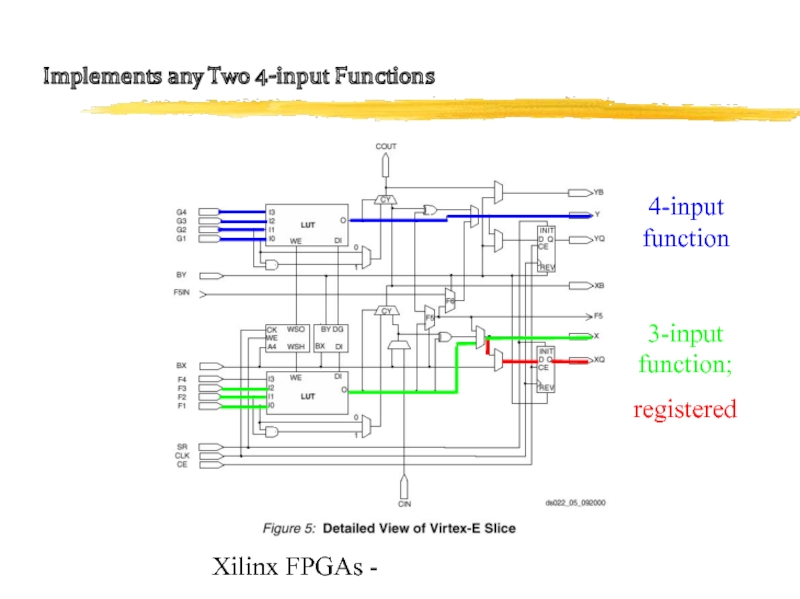
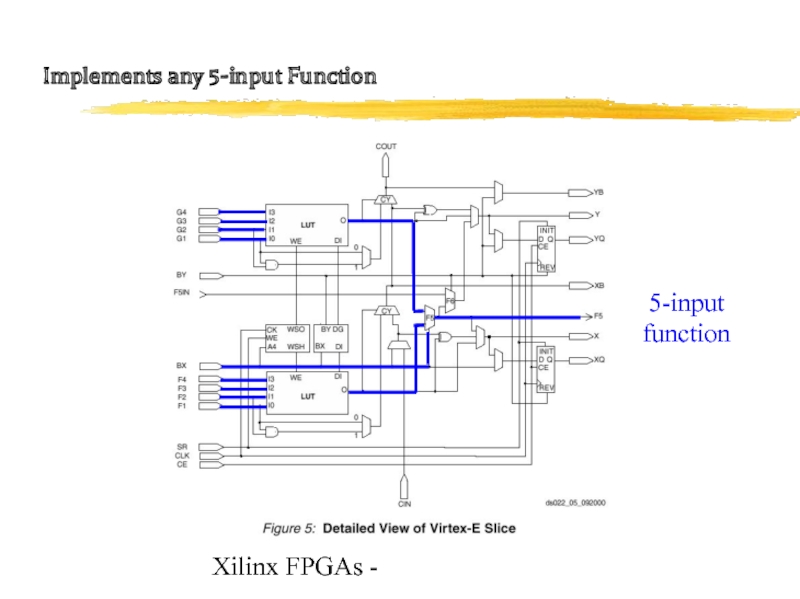
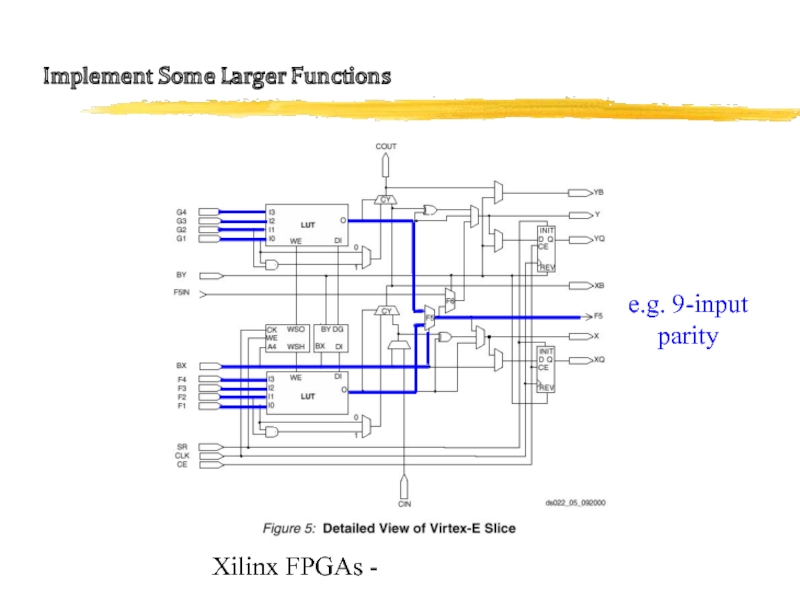
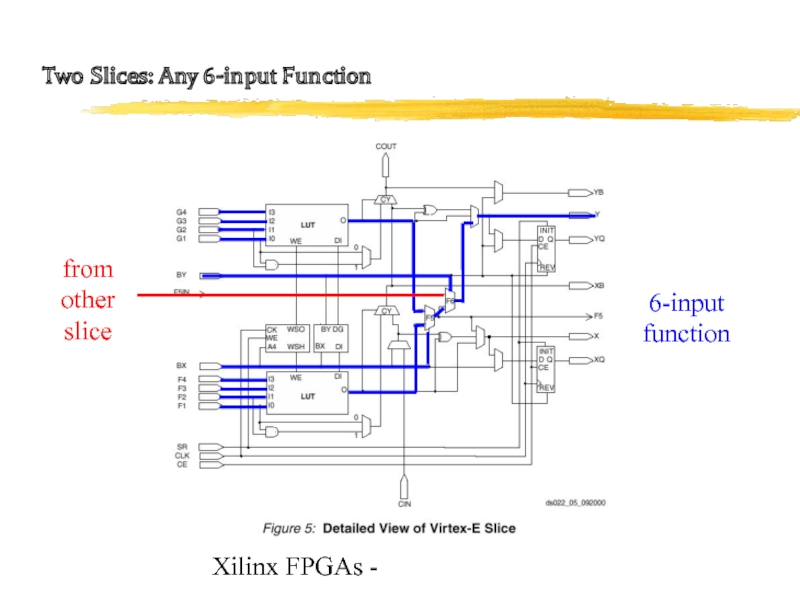
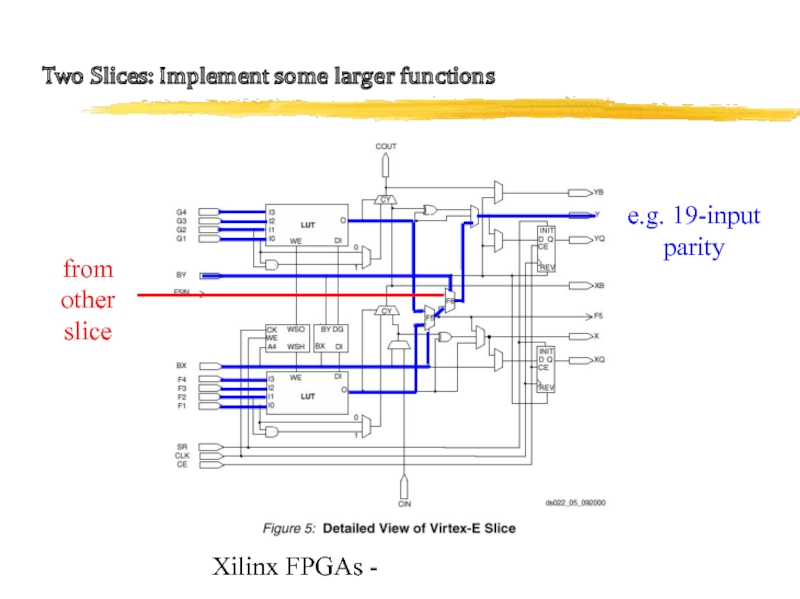
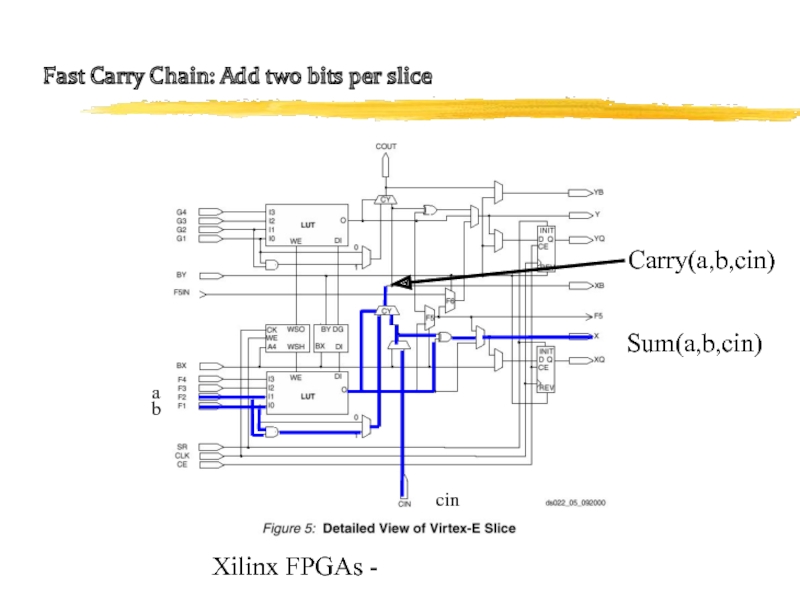
![Xilinx FPGAs - Lookup Tables used as memory (16 x 2) [ Distributed Memory ]](/img/tmb/3/267551/3de2e5f44838cd298368cb1e64e5c06c-800x.jpg)
